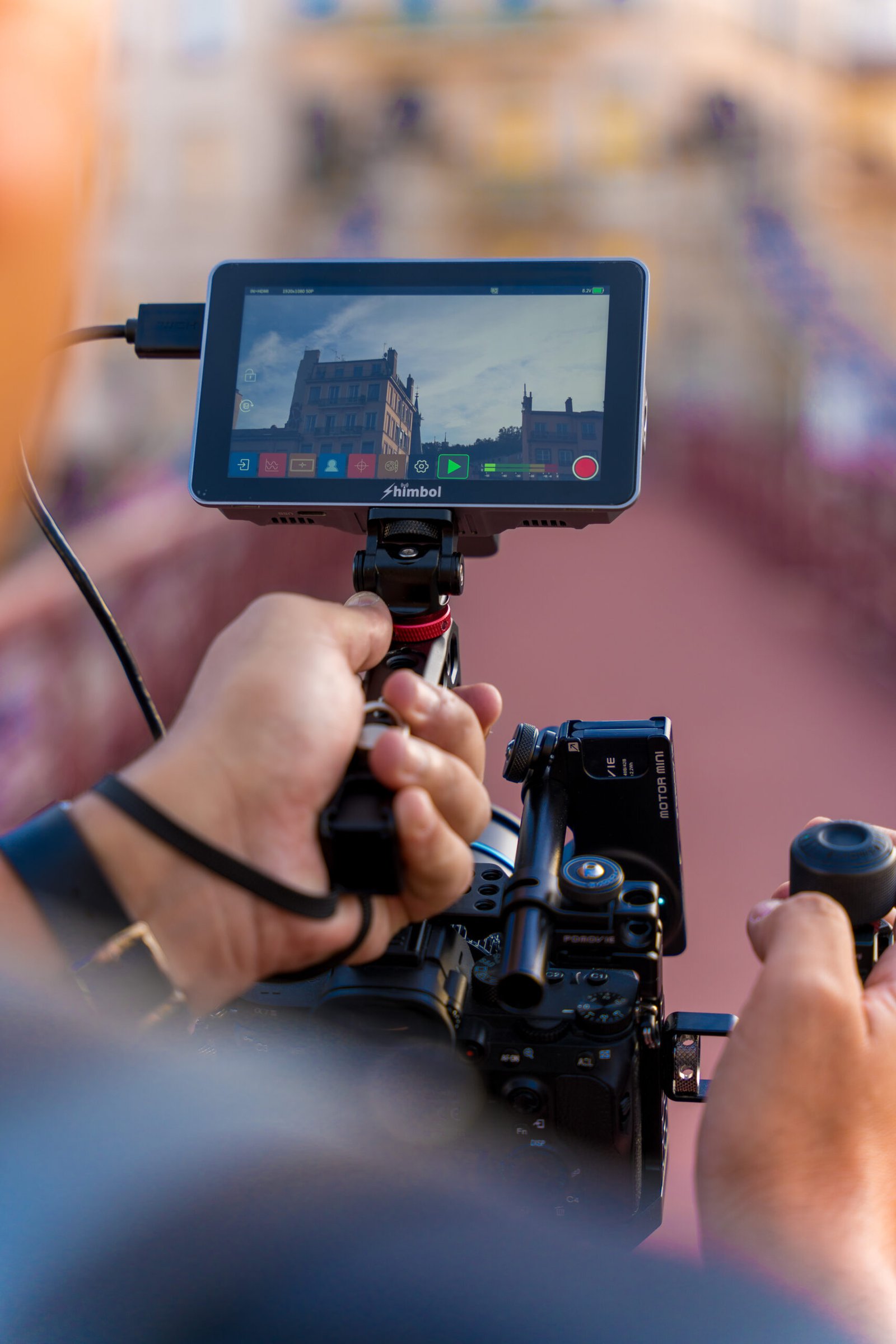Imagine being able to effortlessly stream live events or share your experiences in real-time with family and friends, all without the hassle of tangled wires and bulky equipment. In this article, we explore the potential of wireless video monitors for live streaming purposes. Is it possible to achieve high-quality, uninterrupted live streams with these portable devices? Join us as we examine the practicality and feasibility of using wireless video monitors for live streaming, and discover how they can revolutionize the way we capture and share moments.
What are wireless video monitors?
Definition
Wireless video monitors are devices that enable the transmission of video signals from a camera or other recording device to a display or recording device without the need for physical cables. These monitors use wireless technologies such as Wi-Fi, Bluetooth, or radio frequencies to transmit the video signals wirelessly.
Features
Wireless video monitors come with various features that make them suitable for live streaming. These features may include high-definition video quality, low latency, long-range transmission capabilities, multiple channel options, and compatibility with different types of cameras and recording devices. Some wireless monitors also offer additional functionalities such as built-in microphones, audio monitoring, and touch-screen displays.
Overview of live streaming
Definition
Live streaming refers to the real-time transmission of video and audio content over the internet for immediate viewing by an audience. It allows content creators, businesses, and individuals to share events, performances, presentations, and other forms of live content with viewers worldwide.
Popular platforms
There are several popular platforms that facilitate live streaming, including YouTube Live, Facebook Live, Instagram Live, Twitch, and Periscope. These platforms provide user-friendly interfaces for streaming, audience interaction, and archive storage of live streams.
Benefits
Live streaming offers numerous benefits for both content creators and viewers. It allows creators to reach a wider audience, engage in real-time conversations with viewers, and monetize their content through advertising, sponsorships, or paid subscriptions. For viewers, live streaming provides the opportunity to access and participate in live events, conferences, concerts, and other experiences remotely without geographical limitations.
Challenges
Despite its benefits, live streaming also presents some challenges. The quality and stability of the internet connection can impact the streaming experience, and technical issues such as buffering, latency, or dropped frames can occur. Additionally, ensuring the security and privacy of live streams can be a concern, especially for sensitive or exclusive content.

This image is property of images.pexels.com.
Advantages of wireless video monitors for live streaming
Flexibility and mobility
Wireless video monitors offer flexibility and mobility, allowing content creators to move freely and capture different angles or locations during a live stream. Without the restriction of cables, users can easily adjust their position or change camera angles without disrupting the streaming process.
Easy setup and portability
Wireless video monitors are generally easy to set up and use. They eliminate the need for complicated cable connections, reducing setup time and effort. Moreover, wireless monitors are often lightweight and portable, making them convenient for on-the-go live streaming scenarios.
Reduced cable clutter
One of the primary advantages of wireless video monitors is the elimination of cable clutter. Traditional wired setups often involve long and tangled cables, which can be visually unpleasing, hinder movement, or pose tripping hazards. With wireless monitors, cables are no longer necessary, resulting in a neater and safer environment.
Remote monitoring capabilities
Wireless video monitors often come with remote monitoring capabilities, allowing content creators to view and control the live stream from a distance. This feature is particularly useful for situations where the camera and display or recording device are in separate locations. Remote monitoring enables real-time adjustments to the stream quality, camera settings, and framing without the need to physically access the equipment.
Considerations before using wireless video monitors for live streaming
Compatibility with live streaming platforms
Before using wireless video monitors for live streaming, it is essential to ensure compatibility with the chosen live streaming platform. Different platforms may have specific requirements or recommended equipment, and not all wireless monitors may be compatible. Therefore, it is crucial to research and confirm compatibility to avoid any compatibility issues during live streaming.
Network stability and bandwidth requirements
Wireless video monitors rely on internet connectivity to transmit the video signals. It is crucial to have a stable and reliable network connection, preferably with high bandwidth, to ensure smooth and uninterrupted live streaming. Insufficient bandwidth or a weak network signal can result in buffering, lag, or even complete disconnection during the stream.
Quality and latency issues
The quality of video transmitted by wireless monitors may vary depending on factors such as video resolution, frame rate, and encoding settings. It is crucial to select appropriate settings to achieve the desired video quality while considering the limitations of the network connection and the capabilities of the live streaming platform. Latency, which refers to the delay between the live action and its display on the monitor, should also be minimized to provide a real-time experience for viewers.
Battery life and power options
Wireless video monitors are typically powered by batteries. It is important to consider the battery life and have a backup plan or extra batteries to avoid disruptions during the live stream. Additionally, it may be necessary to have access to power outlets or alternative power sources when operating the monitor for extended periods.

This image is property of images.pexels.com.
Wireless video monitor options for live streaming
Built-in wireless monitors
Some cameras and recording devices come with built-in wireless capabilities, allowing direct streaming to compatible platforms without the need for additional equipment. These built-in wireless monitors often offer convenience and simplicity, as they eliminate the need for separate transmitters or receivers. However, the range and capabilities of built-in wireless monitors may vary between models and manufacturers.
External wireless transmitter-receiver setups
For cameras or recording devices without built-in wireless capabilities, external transmitter-receiver setups can be used. These setups consist of separate components—an external transmitter connected to the camera and an external receiver connected to the display or recording device. The transmitter wirelessly sends the video signal to the receiver, which then displays or records the content. This option provides flexibility, as the transmitter and receiver can be chosen based on specific requirements, such as range, signal strength, or additional features.
Best practices for using wireless video monitors in live streaming
Selecting the right equipment
To ensure a successful live streaming experience, it is essential to select the right wireless video monitor equipment. Consider factors such as compatibility with the chosen live streaming platform, range requirements, video quality capabilities, and additional features that may be necessary for your specific needs. Researching and comparing different options, reading reviews, and seeking recommendations can help in making an informed decision.
Optimizing network setup
To achieve optimal performance, it is important to optimize the network setup. This includes ensuring a strong and stable internet connection, preferably through a wired Ethernet connection instead of relying solely on Wi-Fi. Additionally, configuring network settings, such as prioritizing and allocating sufficient bandwidth for the live streaming application, can help minimize latency and interruptions.
Testing and monitoring during setup
Before starting a live stream, it is crucial to thoroughly test and monitor the wireless video monitor setup. Conducting test streams allows for identifying and resolving any potential issues related to video quality, latency, audio synchronization, or compatibility with the live streaming platform. Regularly monitoring the live stream during the broadcast can help detect and address any unexpected problems in real time, ensuring a smooth viewing experience for the audience.
Backup plans for network failure
Even with the best preparation, network failures can still occur. It is advisable to have backup plans in place to mitigate the impact of such failures. This can involve having alternative internet connections, such as a mobile hotspot or a secondary wired connection, or considering a redundant fail-safe setup with multiple wireless video monitors to switch to in case of network disruptions.

This image is property of images.pexels.com.
Security considerations for wireless video monitors
Encryption and authentication
Security is an important aspect when using wireless video monitors for live streaming. It is essential to ensure the video signals transmitted wirelessly are encrypted to prevent unauthorized access or interception. Encryption protocols, such as WPA2-PSK, offer a higher level of security by encrypting both the video signal and the wireless network connection. Additionally, implementing user authentication methods, such as passwords or user access codes, helps restrict access to the wireless video monitor system.
Secure network setup
Creating a secure network setup is crucial to prevent unauthorized access or tampering. This involves securing the wireless network itself by changing default login credentials, using strong and unique passwords, and regularly updating the firmware of the wireless video monitor equipment. It is also recommended to isolate the network used for live streaming from other networks to minimize the potential for security breaches.
Monitoring access and permissions
To ensure the security of the live stream, it is important to monitor and control access to the wireless video monitor system. Granting different levels of access and permissions to individuals or groups can help prevent unauthorized changes to the live stream settings, content, or other sensitive information. Regularly reviewing access logs, monitoring user activities, and promptly revoking access for those who no longer require it contribute to maintaining a secure environment.
Tips for achieving high-quality live streaming using wireless video monitors
Optimizing video resolution and frame rate
When using wireless video monitors, it is important to optimize the video resolution and frame rate settings for the live stream. Higher video resolutions, such as 1080p or even 4K, offer better visual quality but require more bandwidth. Adjusting the video resolution based on the available network bandwidth and the capabilities of the live streaming platform ensures a smooth and uninterrupted streaming experience. Similarly, selecting an appropriate frame rate, such as 30 or 60 frames per second, contributes to achieving smooth and fluid motion during the live stream.
Choosing appropriate encoding settings
The encoding settings used during live streaming impact both the video quality and the network bandwidth consumption. Selecting the right encoding settings, such as the video codec, bitrate, and compression settings, requires finding the optimal balance between video quality and network efficiency. It is recommended to consult the documentation or support resources provided by the wireless video monitor manufacturer and the live streaming platform for recommended encoding settings.
Positioning and optimizing antenna placement
Proper positioning and optimizing antenna placement can significantly improve the wireless signal strength and quality. It is important to minimize obstructions, such as walls or other objects, between the wireless video monitor and the camera or display device. Positioning the antennas for optimal line-of-sight communication and adjusting their orientation or using external antennas when necessary can help maximize the signal strength and stability.
Reducing interference and maximizing signal strength
Wireless video monitors can be susceptible to interference from other wireless devices or environmental factors such as wireless networks, microwaves, or physical obstructions. To minimize interference, it is recommended to select wireless channels with less congestion or use frequency-hopping techniques. Adjusting the power output of the wireless video monitor, if possible, can help optimize the signal strength and reduce the chances of interference.
Case studies: Successful live streaming using wireless video monitors
Sports events
Wireless video monitors have been extensively used in live streaming sports events. They offer the flexibility to capture the action from various angles and locations, providing an immersive experience for viewers. Additionally, the mobility of wireless monitors allows camera operators to follow the dynamics of the game or match closely, ensuring that every crucial moment is captured and shared with the audience in real time.
Concerts and festivals
Live streaming concerts and festivals has become increasingly popular, and wireless video monitors play a vital role in delivering the live experience to remote viewers. By using wireless monitors, event organizers and video producers can capture and transmit performances from multiple stages or locations simultaneously, creating a virtual concert or festival experience for online audiences. This allows fans from all around the world to enjoy their favorite artists and bands without being physically present at the event.
Broadcasting and news coverage
Wireless video monitors have revolutionized broadcasting and news coverage by enabling real-time reporting and transmission of events from virtually any location. Journalists and reporters can use wireless monitors to capture and stream breaking news, live interviews, or on-location reporting without the limitations of traditional wired setups. This allows news organizations to deliver up-to-the-minute coverage to their audiences, as events unfold.
Webcasts and online conferences
Webcasts and online conferences often rely on wireless video monitors to transmit live presentations, panel discussions, or training sessions to remote participants. The flexibility and mobility of wireless monitors enable presenters to move around, use visual aids, or demonstrate products, enhancing the overall engagement and interaction with the online audience. Wireless video monitors provide a seamless live streaming experience for participants, regardless of their physical location.
Conclusion
Wireless video monitors offer a range of advantages for live streaming, including flexibility, easy setup, reduced cable clutter, and remote monitoring capabilities. However, certain considerations, such as compatibility, network stability, quality issues, and power options, need to be taken into account before using wireless monitors. By following best practices, considering security measures, and optimizing settings, content creators can achieve high-quality live streaming using wireless video monitors. Successful case studies in sports events, concerts, broadcasting, and online conferences demonstrate the effectiveness and widespread use of wireless monitors in live streaming. As technology continues to advance, wireless video monitors are likely to play an increasingly significant role in the future of live streaming.

Meet Penny Sterling, the editor behind the captivating content of our blog, “Wireless Video Monitor.” With a background in electrical engineering and a deep passion for technology, Penny has become a leading authority in the world of wireless video monitors. Her ability to distill complex concepts into accessible articles has made her a trusted guide for both tech enthusiasts and newcomers to the field. Penny’s unwavering commitment to research and staying up-to-date ensures that “Wireless Video Monitor” remains an authoritative source for reliable information. Get ready to embark on a journey of wireless video monitor exploration with Penny Sterling as your knowledgeable and dedicated mentor.


